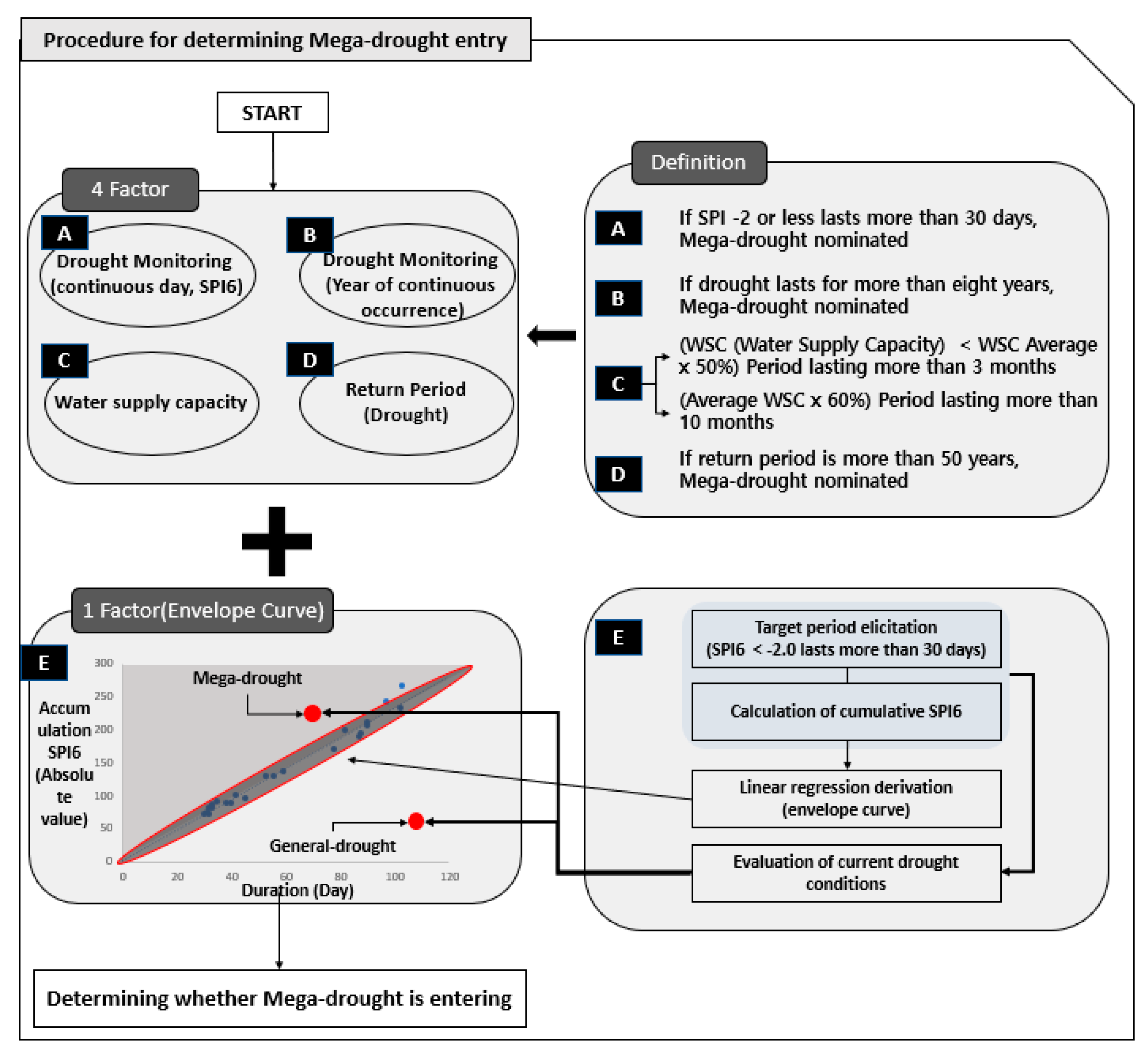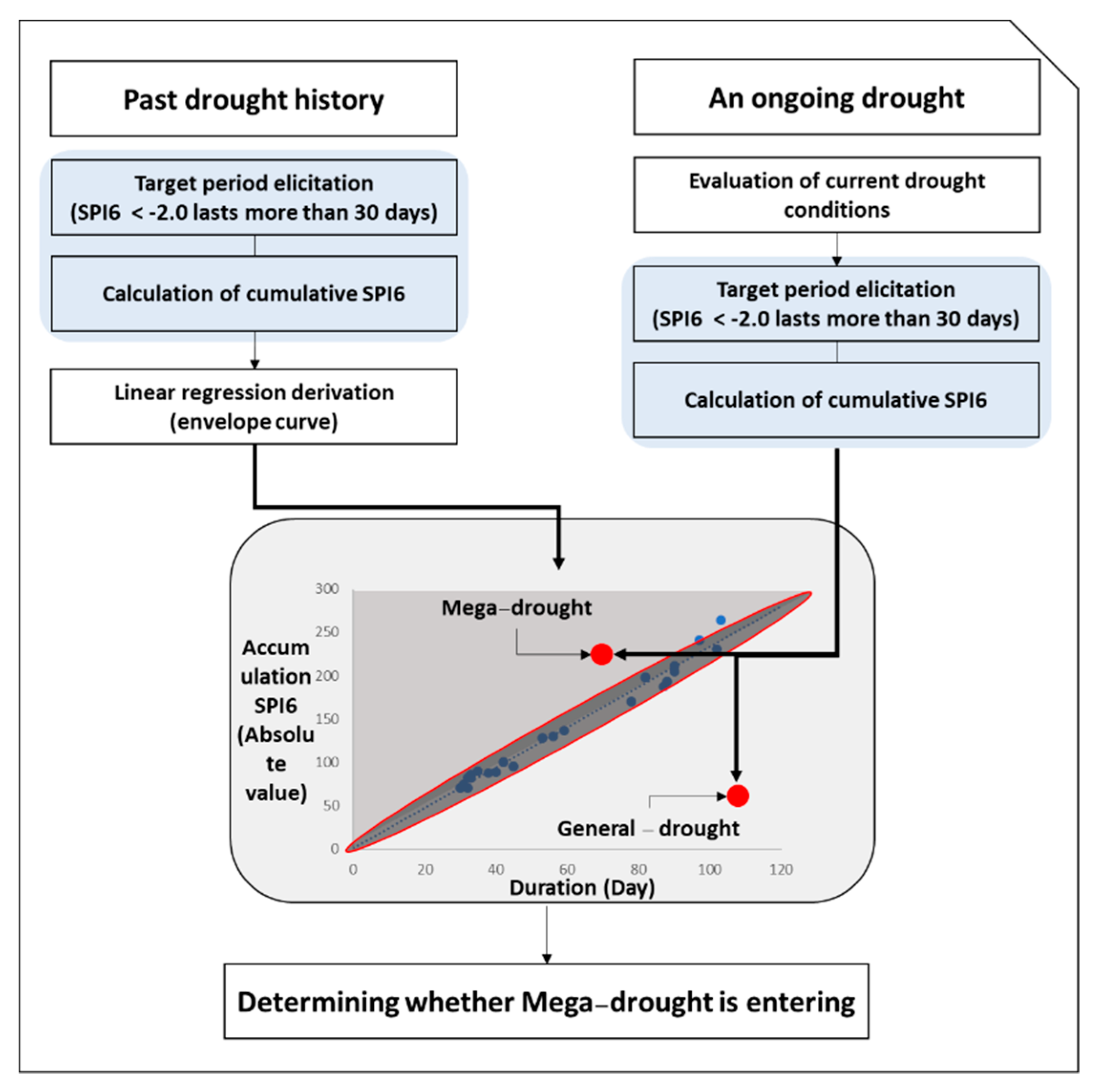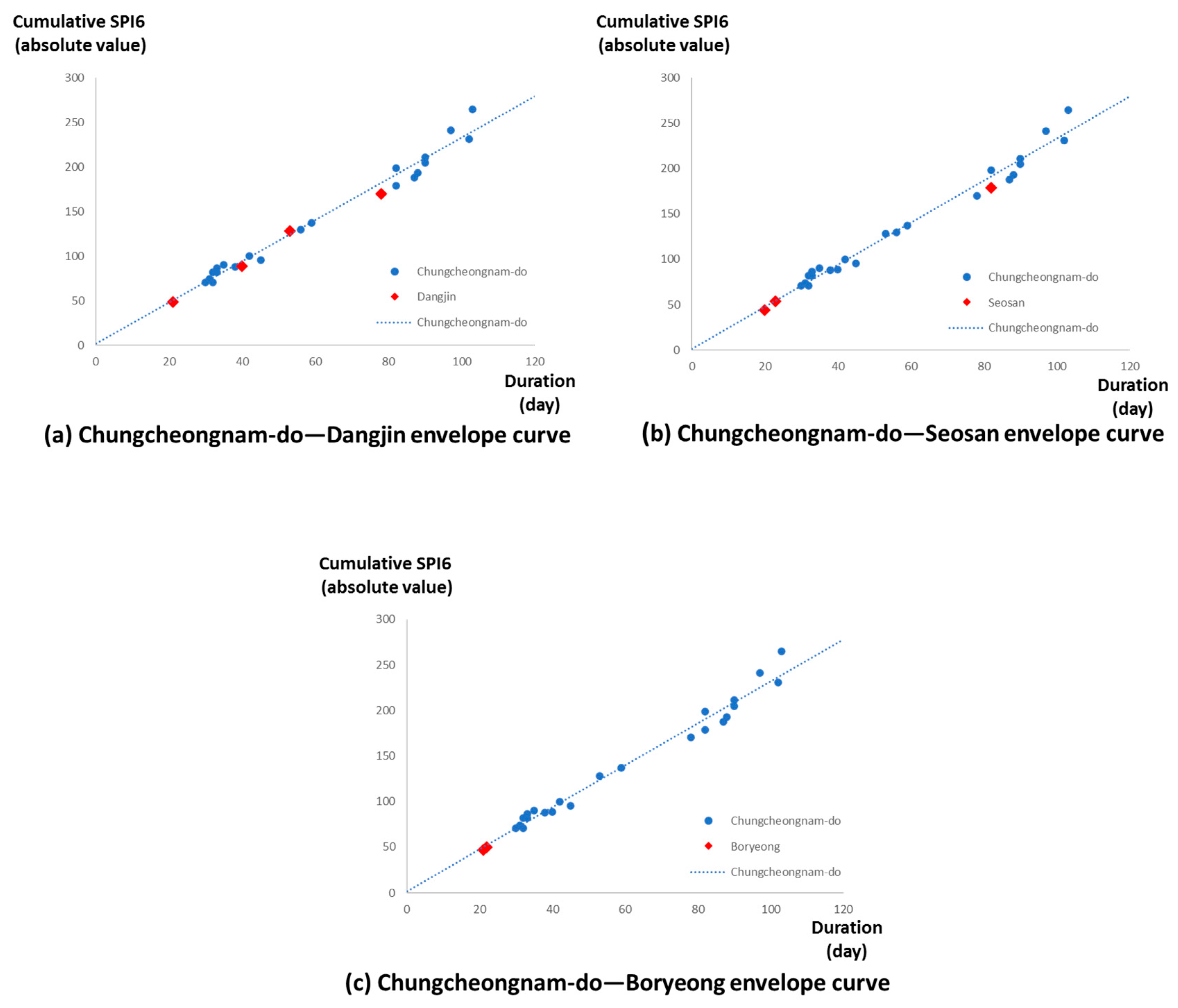Quantitative Determination Procedures for Regional Extreme Drought Conditions: Application to Historical Drought Events in South Korea
Abstract
:1. Introduction
2. Methodology
2.1. Procedure for the Analysis of Extreme Drought
2.2. Factors Determining Extreme Drought
2.2.1. Factor A: Drought Monitoring (Duration, Standardized Precipitation Index)
2.2.2. Factor B: Drought Monitoring (Consecutive Years of Drought)
2.2.3. Factor C: Availability of Water Resources
2.2.4. Factor D: Return Period
2.2.5. Factor E: Determination of Past Regional Extreme Droughts
3. Application and Results
3.1. Status of Applicable Regions
3.2. Analysis of Each Factor
3.2.1. Drought Monitoring (Days of Duration, SPI)
3.2.2. Drought Monitoring (Consecutive Years of Drought)
3.2.3. Water Resource Availability
3.2.4. Drought Recurrence Interval
3.2.5. Determination of Extreme Regional Drought in the Past
3.3. Discussion
4. Conclusions
Author Contributions
Funding
Conflicts of Interest
References
- National Research Council. America’s Climate Choices; National Academies Press: Washington, DC, USA, 2011. [Google Scholar]
- Rind, D. Models see hard rain, drought if CO2 doubles. Clim. Alert Newsl. 1993, 6, 120–125. [Google Scholar]
- Kitoh, A.; Yukimoto, S.; Noda, A.; Motoi, T. Simulated changes in the Asian summer monsoon at times of increased atmospheric CO2. J. Meteorol. Soc. Jpn. 1997, 75, 1019–1031. [Google Scholar] [CrossRef] [Green Version]
- Kim, B.S.; Chang, I.G.; Sung, J.; Han, H.J. Projection in Future Drought Hazard of South Korea Based on RCP Climate Change Scenario 8.5 Using SPEI. Adv. Meteorol. 2016, 2016, 1–23. [Google Scholar] [CrossRef] [Green Version]
- Nam, W.H.; Hayes, M.J.; Wall, N.; Yun, D.H. Public Participation and Outreach Program of Stakeholders for Drought Preparedness: Invitational Drought Tournament. Mag. Korean Soc. Agric. Eng. 2017, 59, 10–16. [Google Scholar]
- Sung, J.; Chung, E.-S.; Shahid, S. Reliability–Resiliency–Vulnerability Approach for Drought Analysis in South Korea Using 28 GCMs. Sustainability 2018, 10, 3043. [Google Scholar] [CrossRef] [Green Version]
- Kogan, F. Application of vegetation index and brightness temperature for drought detection. Adv. Space Res. 1995, 15, 91–100. [Google Scholar] [CrossRef]
- World Meteorological Organization. Droughts and Agriculture, WMO Technical Note 138; World Meteorological Organization: Geneva, Switzerland, 1975. [Google Scholar]
- White, D.H.; O’Meagher, B. Coping with exceptional droughts in Australia. In Drought Network News 7; Wilhite, D.A., Ed.; University of Nebraska: Lincoln, NE, USA, 1995; pp. 13–17. [Google Scholar]
- Palmer, W.C. Meteorological Drought, Research Paper, 45; National Weather Service: Silver Spring, MD, USA, 1965.
- McKee, T.B.; Doesken, N.J.; Kleist, J. The relationship of drought frequency and duration to time scales. In Proceedings of the 8th Conference on Applied Climatology, Boston, FL, USA, 17–22 January 1993. [Google Scholar]
- Nalbantis, I. Evaluation of a hydrological drought index. Eur. Water 2008, 23, 67–77. [Google Scholar]
- Shafer, B.A.; Dezman, L.E. Development of surface water supply index–A drought severity indicator for Colorado. In Proceedings of the International Symposium on Hydrometeorology, Denver, CO, USA, 13–17 June 1982. [Google Scholar]
- Kwon, H.-J.; Kim, S.-J. Evaluation of Semi-Distributed Hydrological Drought using SWSI (Surface Water Supply Index). J. Korean Soc. Agric. Eng. 2006, 48, 37–43. [Google Scholar] [CrossRef]
- Baier, W. Concepts of soil moisture availability and their effect on soil moisture estimates from a meteorological budget. Agric. Meteorol. 1969, 6, 165–178. [Google Scholar] [CrossRef]
- Woodhouse, C.A.; Overpeck, T. 2000 years of drought variability in the central United States. Bull. Am. Meteorol. Soc. 1998, 79, 2693–2714. [Google Scholar] [CrossRef]
- Stahle, D.W.; Cook, E.R.; Cleaveland, M.K.; Therrell, M.D.; Meko, D.M.; Grissino-Mayer, H.D.; Watson, E.; Luckman, B.H. Tree-ring data document sixteenth-century megadrought over NorthAmerica. Eos Trans. Am. Geophys. Union 2000, 81, 121–125. [Google Scholar] [CrossRef]
- Vicente-Serrano, S.M.; Begueria, S.; Lopez-Moreno, J.I. A Multi-scalar Drought Index Sensitive to Global Warming: The Standardized Precipitation Evapotrans-piration Index. J. Clim. 2010, 23, 1696–1718. [Google Scholar] [CrossRef] [Green Version]
- Kim, B.G.; Chung, D.B.; Shin, C.S. Statistical Analysis of Changes in Reservoir Storage According to Standard Precipitation Evapotranspiration Index (SPEI) and Dam Water Release. J. Korean Soc. Hazard Mitig. 2018, 18, 409–415. [Google Scholar] [CrossRef]
- Kim, J.H.; Jeung, S.J.; Lee, S.H.; Kim, B.S. Han River Basin Drought Disaster Analysis Using Extreme Drought Index. In Proceedings of the Korea Water Resources Association Conference, Daejeon, Korea, 26–27 May 2016; p. 243. [Google Scholar]
- Park, D.H.; Kim, T.U. Establishment of Emergency Plan for Extreme Water Insufficient by Catchment and Region. Water Future 2015, 48, 30–36. [Google Scholar]
- Hydrological Weather Drought Information System [Drought Analysis Menu] in KMA. Available online: http://hydro.kma.go.kr/drought/obsAdm.do (accessed on 5 May 2020).
- Hydrological Weather Drought Information System [Drought Index Menu] in KMA. Available online: http://hydro.kma.go.kr/help/menu902.do (accessed on 5 May 2020).
- Hashimoto, T.; Stedinger, J.R.; Loucks, D.P. Reliabilty, resilency, and vulnerabilty criteria forwater resources system performance evaluation. Water Resour. Res. 1982, 18, 14–20. [Google Scholar] [CrossRef] [Green Version]
- Moy, W.S.; Cohon, J.L.; Revele, C.S. Aprogramming model for analysis of the reliabilty, resilence, and vulnerabilty of a water suply reservoir. Water Resour. Res. 1986, 2, 489–498. [Google Scholar] [CrossRef]
- Kang, M.G.; Park, S.W. Asesment ofaditonal water suply capacity using a reservoiroptimal operation model. J. Korea Water Resour. Asoc. KWRA 2005, 38, 937–946. [Google Scholar] [CrossRef]
- Lee, S.H.; Kang, T.U. An evaluation methodof water suply reliabilty for a dam by firm yieldanalysis. J. Korea Water Resour. Asoc. KWRA 2006, 39, 467–478. [Google Scholar]
- Lee, J.H.; Kim, C.J. Drought Hearts-Drought Time-Birth Frequency Curve through Drought Frequency Analysis. J. Korea Water Resour. Asoc. 2011, 44, 889–902. [Google Scholar] [CrossRef] [Green Version]
- Artusa, A. Drought Map. U.S. Drought Monitor. Available online: http://droughtmonitor.unl.edu/ (accessed on 5 May 2020).
- Svoboda, M.; LeComte, D.; Hayes, M.; Heim, R.; Gleason, K.; Angel, J.; Miskus, D. The drought monitor. Bull. Am. Meteorol. Soc. 2002, 83, 1181–1190. [Google Scholar] [CrossRef] [Green Version]
- Yoon, Y.S.; Lee, Y.G.; Lee, J.W.; Kim, S. Short Term Drought Forecasting using Seasonal ARIMA Model Based on SPI and SDI- For Chungju Dam and Boryeong Dam Waterhseds. J. Korean Soc. Agric. Eng. 2019, 61, 61–74. [Google Scholar]
- Yong-Tak Kim, Y.T.; Kim, J.Y.; Lee, J.J.; Kwon, H. Assessment of Drought Characteristics and Return Period for 2015. Korean Soc. Civ. Eng. 2015, 63, 14–24. [Google Scholar]







| Drought Category | SPI Values | Source | |
|---|---|---|---|
| Mild drought | 0 ~ −0.99 | Mckee et al. (1993) [11] | |
| Moderate drought | −1.00 ~ −1.49 | ||
| Severe drought | 1.50 ~ −1.99 | ||
| Extreme drought | −2.00 ≥ SPI | ||
| Experience | Less than −2.0 lasting for more than 20 days | Korea Meteorological Administration [23] | |
| Analysis & survey | Less than −2.0 lasting for more than 30 days | This study | |
| Name of Region | No. | Duration | Absolute Cumulative Sum of SPI6 | Source | ||
|---|---|---|---|---|---|---|
| Start | End | Days | ||||
| Suwon | 1 | 14 March 1997 | 8 April 1997 | 25 | 53.14 | Korean Meteorological Administration [22] |
| 2 | 5 April 1978 | 24 April 1978 | 20 | 44.79 | ||
| 3 | 22 August 2015 | 30 December 2015 | 131 | 299.78 | ||
| Geochang | 4 | 1 April 2009 | 27 May 2009 | 57 | 127.8 | |
| Yeongcheon | 5 | 10 March 1995 | 17 April 1995 | 39 | 83.75 | |
| 6 | 8 May 2009 | 30 May 2009 | 23 | 51.61 | ||
| Cheorwon | 7 | 7 October 2014 | 2 April 2015 | 178 | 386.63 | |
| Seosan | 8 | 2 June 1978 | 23 June 1978 | 22 | 48.29 | |
| 9 | 27 November 1988 | 20 January 1989 | 55 | 110.81 | ||
| 10 | 20 July 1992 | 12 August 1992 | 24 | 51.17 | ||
| 11 | 10 September 2014 | 7 November 2015 | 59 | 127.46 | ||
| Cheonan | 12 | 9 August 2015 | 24 November 2015 | 108 | 283.61 | |
| Buyeo | 13 | 2 May 1978 | 23 May 1978 | 22 | 47.79 | |
| 14 | 3 July 1982 | 25 July 1982 | 23 | 48.38 | ||
| 15 | 18 November 2001 | 28 December 2001 | 41 | 89.42 | ||
| 16 | 15 August 2015 | 12 November 2015 | 90 | 215.07 | ||
| Boryeong | 17 | 19 July 1982 | 14 August 1982 | 27 | 56.75 | |
| 18 | 1 October 1982 | 11 November 1982 | 42 | 86.55 | ||
| 19 | 14 July 1995 | 20 August 1995 | 38 | 79.03 | ||
| 20 | 8 June 2012 | 30 June 2012 | 23 | 48.89 | ||
| 21 | 1 July 2019 | 25 July 2019 | 25 | 52.19 | ||
| Average | 51.05 | 113.95 | ||||
| Survey Subject | Average | Personnel | |
|---|---|---|---|
| (A) Duration (Days) | (B) Consecutive Years (Years) | ||
| Expert | 66.5 | 8.3 | 26 |
| Public Official | 22.2 | 7.9 | 31 |
| Farmers | 18.8 | 7.2 | 30 |
| Public | 21.9 | 8.5 | 84 |
| Average (total) | 32.4 | 8.0 | 171 |
| Name of Region | Duration (days) | Cumulative SPI6 (Absolute Value) | Cumulative SPI6/Cumulative Days | ||
|---|---|---|---|---|---|
| Start | End | Cumulative Days | |||
| Dangjin | 5 May 2000 | 26 June 2000 | 53 | 128.04 | 2.42 |
| 11 July 2000 | 19 August 2000 | 40 | 88.95 | 2.22 | |
| 27 April 2008 | 17 May 2008 | 21 | 48.81 | 2.32 | |
| 23 August 2015 | 8 November 2015 | 78 | 170.18 | 2.18 | |
| Seosan | 23 January 2007 | 14 February 2007 | 23 | 53.58 | 2.33 |
| 28 April 2008 | 17 May 2008 | 20 | 44.02 | 2.20 | |
| 13 August 2015 | 2 November 2015 | 82 | 178.59 | 2.18 | |
| Boryeong | 5 May 2000 | 25 May 2000 | 21 | 46.81 | 2.23 |
| 22 January 2007 | 12 February 2007 | 22 | 49.64 | 2.26 | |
| Target Area | Area Name | Start | End | Cumulative Days | Cumulative SPI6 (Absolute Value) |
|---|---|---|---|---|---|
| Chungcheongnam-do | Gyeryong | 22 August 2001 | 11 November 2001 | 82 | 198.45 |
| 8 December 2015 | 22 November 2015 | 103 | 264.63 | ||
| Hongseong | 8 February 2002 | 17 March 2002 | 38 | 87.92 | |
| 12 January 2007 | 12 February 2007 | 32 | 70.62 | ||
| Nonsan | 25 August 2001 | 8 October 2001 | 45 | 95.4 | |
| 13 August 2015 | 22 November 2015 | 102 | 231.04 | ||
| Gongju | 17 August 2015 | 12 November 2015 | 88 | 193.04 | |
| Sejong | 17 August 2015 | 11 November 2015 | 87 | 187.72 | |
| Taean | 1 June 1978 | 2 July 1978 | 32 | 82.02 | |
| 16 May 2000 | 17 June 2000 | 33 | 82.03 | ||
| 12 January 2007 | 15 February 2007 | 35 | 90.24 | ||
| 21 August 2015 | 25 November 2015 | 97 | 241.01 | ||
| Seosan | 12 January 2007 | 13 February 2007 | 33 | 86.24 | |
| 15 August 2015 | 12 November 2015 | 90 | 211.08 | ||
| Cheongyang | 9 February 2009 | 10 March 2009 | 30 | 70.97 | |
| Seocheon | 29 April 2000 | 9 June 2000 | 42 | 99.9 | |
| Asan | 29 April 2000 | 26 June 2000 | 59 | 137.15 | |
| 15 August 2015 | 12 November 2015 | 90 | 204.49 | ||
| Cheonan | 29 April 2000 | 29 May 2000 | 31 | 74.05 | |
| Buyeo | 15 August 2015 | 9 October 2015 | 56 | 129.78 |
| Extreme Drought Factors | Conditions | ||
|---|---|---|---|
| Dangjin | Seosan | Boryeong | |
| (A) Drought monitoring (Days of continuation, under SPI −2 and continuing for less than 30 days) | ○ | ○ | × |
| (B) Drought monitoring (Consecutive Years of Drought) | × | × | × |
| (C) Period of water availability | ○ | ○ | ○ |
| (D) Period of drought recurrence (Period of recurrence of 50 years or more) | × | × | × |
| (E) Region-based envelope curve | × | × | × |
© 2020 by the authors. Licensee MDPI, Basel, Switzerland. This article is an open access article distributed under the terms and conditions of the Creative Commons Attribution (CC BY) license (http://creativecommons.org/licenses/by/4.0/).
Share and Cite
Lee, C.W.; Park, M.J.; Yoo, D.G. Quantitative Determination Procedures for Regional Extreme Drought Conditions: Application to Historical Drought Events in South Korea. Atmosphere 2020, 11, 581. https://doi.org/10.3390/atmos11060581
Lee CW, Park MJ, Yoo DG. Quantitative Determination Procedures for Regional Extreme Drought Conditions: Application to Historical Drought Events in South Korea. Atmosphere. 2020; 11(6):581. https://doi.org/10.3390/atmos11060581
Chicago/Turabian StyleLee, Chan Wook, Moo Jong Park, and Do Guen Yoo. 2020. "Quantitative Determination Procedures for Regional Extreme Drought Conditions: Application to Historical Drought Events in South Korea" Atmosphere 11, no. 6: 581. https://doi.org/10.3390/atmos11060581
APA StyleLee, C. W., Park, M. J., & Yoo, D. G. (2020). Quantitative Determination Procedures for Regional Extreme Drought Conditions: Application to Historical Drought Events in South Korea. Atmosphere, 11(6), 581. https://doi.org/10.3390/atmos11060581







